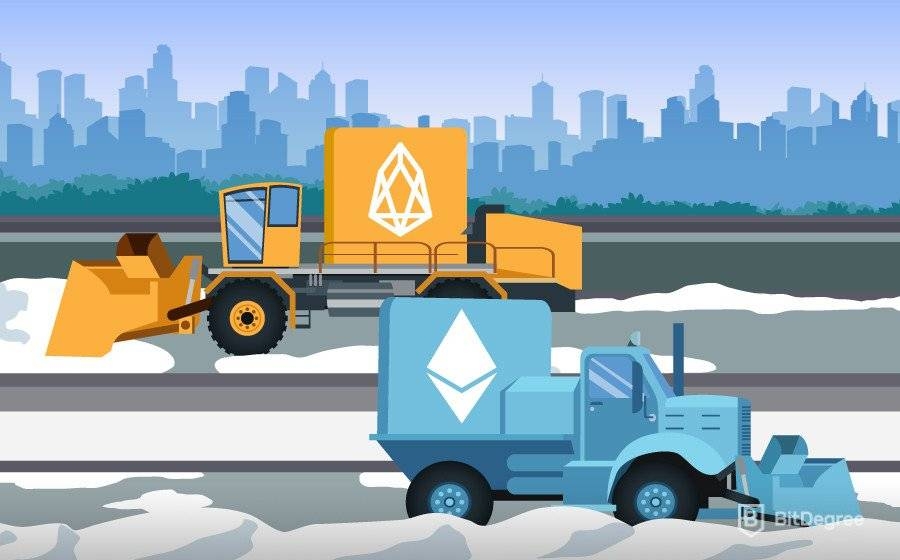Stop overpaying - start transferring money with Ogvio. Sign up, invite friends & grab Rewards now! 🎁
So, you’ve heard about two of the most popular smart contract blockchains, but want to know which is better in the EOS VS Ethereum battle? Or maybe you want to find out how the two technologies compare? Well, you’ve come to the right place, as I am going to tell you everything you need to know!
In this EOS VS Ethereum guide, I am going to start by explaining the basics of each project, followed by an overview of how each blockchain performs. This will include things such as transaction times, transaction fees and scalability.
After that, I will then give you a simple breakdown of how transactions are verified without a third party. This will include a comparison between the Proof of Work model used by Ethereum, and the Delegated Proof of Stake model used by EOS.
Finally, I will give you my own opinion on what I think the future holds for each blockchain. So, by the end of reading my EOS VS Ethereum guide, you will be able to decide what the best alternative is!
Note that if you'd like to purchase some ETH or EOS for yourself, make sure to do so via a trusted exchange platform. Notable examples include Binance, Coinbase, and Kraken.
What are you waiting for? Let’s start by finding out the basics of each blockchain!

Did you know?
Subscribe - We publish new crypto explainer videos every week!
What is a Crypto Mining Pool? Is it Worth it? (Beginner-Friendly)


Table of Contents
The Basics
What is Ethereum?
Ethereum was launched in 2015 by a young Canadian-Russian programmer called Vitalik Buterin. It is a blockchain platform that allows people to send and receive funds, without the need for a third party, such as a bank.
The Ethereum project became the first blockchain protocol to install something called ‘smart contract’ technology, which allows strangers to agree on a trustless environment. The technology is based on pre-defined conditions and once these are met, the smart contract can release the funds automatically without the help of an intermediary.
To give you an idea of how much potential this has, take a look at the following example.
- James owns a farm. He decides that he wants to take out insurance if it doesn’t rain for more than 7 days.
- Instead of using a third party, James decides to enter into a smart contract.
- To activate the smart contract, James deposits the insurance fee.
- The smart contract can analyze thousands of web pages to check the weather history.
- If it doesn’t rain for 7 days or more, the smart contract will pay out James automatically. If it does rain, then James loses his insurance fee.
- All of this is possible without a third party!
The above example can be used to benefit multiple industries, including banking, energy, gambling, and even political elections!
Ethereum also has its cryptocurrency called Ether (ETH), which is traded on most cryptocurrency exchanges. In total, there are just over 100 million coins in circulation. Although there is no limit to the number of coins that can be issued, Vitalik Buterin has suggested that he will probably restrict more coins from being created.
Just like Bitcoin, the Ethereum blockchain is decentralized, meaning that nobody controls it. This prevents any single person or authority from changing or amending the data that is posted to the blockchain.
Instead, transactions are confirmed by the Ethereum community, who in return, are rewarded for contributing their extra computational power. I’ll talk about this in more detail later on.
So, now that you know some of the basics of Ethereum, the next part of my EOS VS Ethereum guide is going to discuss the basics of EOS!
What is EOS?
EOS is one of many Ethereum alternatives. It is a brand new blockchain project that also can handle smart contracts. Block. One, a company located in the Cayman Islands, first launched the project in 2017.
The leading developer working on it is Daniel Larimer, who also founded highly successful projects BitShares and Steem. Larimer’s other projects have been so successful that they are now worth billions of dollars!
EOS recently made history when its one-year initial coin offering (ICO) raised more than $2.5 billion in funding. This makes it one of the biggest ICOs of all time! Just like Ethereum, EOS also has its cryptocurrency, which can be used to send and receive funds, wallet-to-wallet.
The ultimate aim of EOS is to be the fastest, cheapest and most scalable smart contract blockchain in the world. As a result, it wants to win a large percentage of Ethereum’s market share.
The EOS blockchain is also decentralized, meaning that it isn’t controlled by any single person or entity. In a similar way to Ethereum, transactions are verified by the community.
Interestingly, EOS tokens were originally built on top of the Ethereum blockchain, meaning they were ERC-20 tokens. However, after the Main-Net launch on June 2018, the team began exchanging these for official EOS coins that are now backed by the EOS blockchain.
According to the developers, it is hoped that the total EOS coin supply will initially be capped at 1 billion coins, with a 5% yearly inflation. I’ll explain what this is used for later!
Although EOS and Ethereum sound like they are very similar, some clear differences set them apart. Therefore, the next part of my Ethereum VS EOS guide is going to look at how the two blockchains perform!
Performance

Did you know?
Subscribe - We publish new crypto explainer videos every week!
What is a Rug Pull in Crypto? (Meaning + Examples)


Ethereum
As the first and original smart contract blockchain, it is important to understand how it handles transactions. Firstly, it takes an average of 16 seconds for a transaction to be verified on the public blockchain.
This includes a movement of funds, as well as confirming smart contracts. It makes no difference where the sender and receiver are located, the transaction time is always the same. This is impressive, as it can take up to three days for a bank to process an international payment.
So, what about transaction fees? When Ethereum was first launched in 2015, it was possible for the network to verify a transaction at a cost of less than 1 cent. As time has gone by and more people have started to use it, this has slowly increased.
The most expensive period was back in December 2017, where it cost an average of $4 to send a transaction. This made Ethereum unsuitable for transferring small amounts. Fortunately, this has since been reduced to less than $1, however, this can easily go back up if the network experiences a busy period.
The most worrying issue for the Ethereum blockchain is regarding the scalability of transactions. Scalability refers to how well a network can handle lots of transactions at one time. For example, Visa can process up to 50,000 transactions every second, and the banking industry uses systems that can do even more!

However, in the case of Ethereum, the blockchain is only able to handle a maximum of 15 per second. This is a major problem, and if not resolved, it won’t experience global adoption. Luckily for ETH investors, the Ethereum team is working on a few different solutions to this problem which I will discuss later.
Anyway, now that you know how Ethereum performs, the next part of my EOS VS Ethereum guide is going to look at how EOS compares!

- Secure and reliable
- Accepts fiat currencies
- Lots of trading options
- Reputable exchange
- Accepts fiat currencies
- Offers various trading options

- Huge trading variety
- Regulation-compliant around the globe
- Fair trading fees
- Beginner-friendly
- A wide array of features
- Vast number of different crypto coins & tokens

- Beginner-friendly
- Secure
- Decent trading and withdrawal fees
- Crypto.com Visa Card
- Automated tools & bots
- Ecosystem synergy with CRO
EOS
Before I continue, it is really important that you understand a key difference in this EOS VS Ethereum discussion. While Ethereum is a highly established blockchain project with a fully functional platform, EOS is still in its very early days. However, the team has some huge ambitions.
Until there is a finished product though, there is no way to guarantee whether they will achieve all of their goals. Nevertheless, let’s take a look at what the EOS team is looking to achieve.
The main target market for the EOS platform is decentralized applications (dApps). Essentially, dApps are like internet or mobile apps such as YouTube, Facebook, and Gmail, but instead of having a centralized point of control, they are decentralized!
For more information on dApp’s, click here to read my guide!
Ethereum is currently stuck at 15 transactions per second, whereas EOS is planning to raise the bar and scale to millions of EOS transactions per second. This would not only make it the most scalable blockchain in the industry, but it would be able to handle any real-world application.
For example, did you know that over 52,000 Facebook “Likes” happen every single second of the day? Every “Like” is an individual data transaction that the system has to process. An application like Facebook would be perfect for EOS if it can achieve these scalability goals.
At the time of writing in July 2018, EOS has successfully managed 1,000 EOS transactions per second. The team achieved during its testing phase three months ago. This is already significantly better than Ethereum, however, it is well short of its ultimate target.
So, what about fees? Well, according to the EOS white paper, there will be NO transaction fees to pay when sending and receiving funds! The reason why the network can do this is that when people help verify transactions, they are rewarded out of newly created EOS coins (I’ll talk about this in the next section).
The EOS white paper also states that the blockchain will be able to confirm a transaction as 99.9% valid after just 0.25 seconds, and 100% valid after 1 second!
All in all, if EOS can achieve its goals of near-instant and free transactions with the ability to scale to the millions, there is no other blockchain in the industry that will be able to compete.
Here's a comparison table to recap on some of the things spoken about so far!
| Consensus Mechanism |
Transactions Per Second |
Market Value |
Circulating Supply |
Launch Date | Team | Transaction Fees |
|
| EOS | DPoS | 1,000+ | 6.9 Bil | 896 Mil | June 2017 | Block.One | Free |
| ETH | PoW | 15 | 44 Bil | 100 Mil | July 2015 | Ethereum Foundation |
<$1 |
So, now that you know what Ethereum can do and what EOS is planning to do, the next part of my EOS VS Ethereum guide is going to look at how the two blockchains confirm transactions.
Reaching Consensus

Did you know?
Subscribe - We publish new crypto explainer videos every week!
What is a Rug Pull in Crypto? (Meaning + Examples)


Ethereum
Before I continue, I just wanted to make sure that you understand what I mean by “Consensus Mechanism”. As blockchains are decentralized, they can verify transactions without needing to use an intermediary.
Different blockchains reach consensus in different ways. So, they all confirm transactions as valid, but in different ways.
The consensus mechanism used by Ethereum is called Proof of Work, which is the same as other popular blockchains such as Bitcoin, Bitcoin Cash, and Litecoin. Here’s how it works:
The blockchain generates a random puzzle that must be solved before the transaction can be confirmed. However, this puzzle is so difficult that no human could solve it. Instead, it requires a computer (‘node’) to solve.
Anyone that decides to contribute to the Ethereum network can do so by connecting a GPU device to the network. These people are known as “Miners”, and there are thousands of them all competing to be the first to solve the puzzle. Whichever device gets there first, gets the Ether reward!
Although this is a great system to keep the network decentralized, there are some major issues. Firstly, because the puzzle is so difficult, the computational power required is high. This means that it consumes a lot of electricity, which is expensive and bad for the environment.
Also, the 15 transactions per second scalability issue mentioned in this EOS VS Ethereum guide earlier is due to the limits of Proof of Work.
This is why the Ethereum team are planning to change their consensus mechanism to something called Proof of Stake. Not only is Proof of Stake better for the environment, but it also allows the network to process more transactions.
Ethereum is also looking to install two new protocols called “Sharding” and “Plasma”, which will increase the number of transactions the network can handle. Ultimately, it is hoped that these solutions will allow Ethereum to process thousands of transactions per second.
So, now that you know how Ethereum transactions are processed, the next part of my EOS VS Ethereum guide is going to look at how EOS does it!

- Secure and reliable
- Accepts fiat currencies
- Lots of trading options
- Reputable exchange
- Accepts fiat currencies
- Offers various trading options

- Huge trading variety
- Regulation-compliant around the globe
- Fair trading fees
- Beginner-friendly
- A wide array of features
- Vast number of different crypto coins & tokens

- Beginner-friendly
- Secure
- Decent trading and withdrawal fees
- Crypto.com Visa Card
- Automated tools & bots
- Ecosystem synergy with CRO
EOS
Unlike Ethereum and its Proof of Work model, EOS does things differently. The consensus mechanism that is used to support the network is called the Delegated Proof of Stake (or DPoS). Interestingly, DPoS was invented by EOS founder Dan Larimer!
To clarify, the Proof of Stake system allows anyone with a certain amount of coins to help verify transactions on the network. The chances of winning the reward are based on the number of coins you hold.
For example, if you hold 5% of the total supply, you would essentially have a 5% chance of winning the mining reward every time a new block is created.
On the other hand, in DPoS, holding coins does not allow you to validate transactions. However, it instead allows you to vote on “who” should verify transactions. In a way, it’s like a democracy.

The people that you can vote for are called "Block Producers", these are the ones that verify transactions and earn rewards for doing so. In total 21 block producers are responsible for keeping the network secure.
If the block producer does not do their job properly, then they will be replaced by another block producer who is waiting for their turn. This is like voting in the U.S. election. “Should we keep Donald Trump, or should we replace him with somebody better?”
Moving on, you might remember earlier in this Ethereum VS EOS guide that I said EOS transactions are free. But if this is the case, how are block producers rewarded for their time? Well, this is where things get interesting!
As you will see from the below image, every year the total supply of EOS coins will increase by 5%. This is similar to real-world inflation, where a central bank prints more money. Out of this 5%, 1% is given to the block producers as a reward for validating transactions, which means that users don’t need to pay any transaction fees when they send funds.

Anyway, although the EOS blockchain and its DPoS consensus are still being built, it is important to remember that BitShares (which was also created by Dan Larimer) also uses DPoS. The Bitshares network can scale to 100,000 transactions per second, so that’s a good sign!
So, now that you know how each blockchain confirms transactions, in the final part of my EOS VS Ethereum guide, I am going to let you know my opinion on what the future holds!
EOS VS Ethereum: What does the Future Hold?
Before I continue my EOS VS ETH guide, I just wanted to make it clear that any prediction I make is nothing but my personal opinion. The most important thing is that you conduct your independent research.
Firstly, whichever side you are on in the EOS VS Ethereum argument, both projects have performed well in the cryptocurrency market.
Ethereum is the second most popular cryptocurrency in the world, just behind Bitcoin. In 2017 it increased its value by more than 10,000% and reached an all-time high of $130 billion in market capitalization. Not only this, but hundreds of cryptocurrency tokens have been built on top of the Ethereum blockchain and it is also home to over a thousand dApps.
When it comes to EOS, although it is still in its early days, it has performed exceptionally well. As I mentioned earlier in my EOS VS Ethereum guide, the project raised more than $2.5 billion during its one-year ICO.
During the ICO, investors were buying, selling and trading the EOS coin, pushing EOS to a market cap of more than $17 billion. This is very impressive for a project that is yet to release its final product.
However, EOS is yet to achieve anything like what Ethereum has achieved. With that being said though, if EOS can achieve their goals, then it will be a significantly better blockchain than Ethereum.
If EOS can achieve instant, free and millions of EOS transactions per second, it will be very difficult for Ethereum to match that level of performance. However, if Ethereum can implement ‘Proof of Stake’, ‘Sharding’ and ‘Plasma’ successfully, I think it will be tough for Ethereum alternatives to pass Ethereum.
But just like EOS, there is no guarantee that they will be able to achieve this. Let this be a reminder that the cryptocurrency market is a difficult industry to predict, and it is also one of the fastest-changing industries in the world!
So, all you can do is check for regular updates on both of the blockchains’ development progress!
Ethereum VS EOS: The Conclusion
And that’s the end of my EOS VS Ethereum guide. As per usual, I hope you have found this enjoyable, but most of all - knowledgeable!
If you have read this guide from start to finish, you should now know how the EOS and Ethereum blockchains perform technically, as well as what they have planned for the future.
Not only this, but you should also know the difference between Proof of Work and Delegated Proof of Stake, and how these two consensus algorithms are different.
As I mentioned earlier, the EOS VS ETH debate is something that divides opinions. I understand both sides of the argument because while EOS has the potential to become the best-performing blockchain in the world, Ethereum is already the second most popular cryptocurrency in the industry. So, it is a difficult one to call.
Ultimately though, I think it is a battle of the tech. So, let’s see how well each blockchain performs in a year, then maybe we will be able to make a decision. And, after doing so, if you'll want to acquire some cryptocurrencies for yourself, you can check out Binance, Kraken, Coinbase, or KuCoin (or any other high-end crypto exchange)!
Anyway, I hope my guide has helped you clear up a few unanswered questions. Now, with your new-found knowledge, which blockchain do you prefer and why? Or do you feel like there are better Ethereum Alternatives than EOS? Feel free to let me know in the comments section below!
The content published on this website is not aimed to give any kind of financial, investment, trading, or any other form of advice. BitDegree.org does not endorse or suggest you to buy, sell or hold any kind of cryptocurrency. Before making financial investment decisions, do consult your financial advisor.









